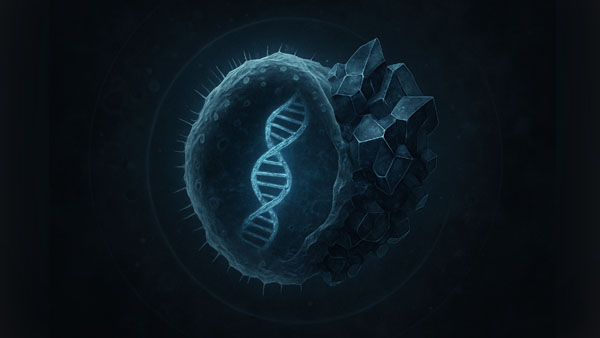By Satyabrat Borah
Scientists have recently uncovered a new entity that exists in a perplexing space between life and non-life, challenging long-standing definitions of what it means to be alive. Viruses, which rely heavily on host organisms for most of their functions, are typically not considered living entities. However, this newly discovered creature complicates that classification, blurring the boundaries between life and non-life. This finding has sparked intense debate among biologists, philosophers, and researchers, prompting a reevaluation of the criteria used to define life. In this article, we will explore the characteristics of this enigmatic entity, its implications for biology, its potential impact on various scientific fields, and the broader philosophical questions it raises about the nature of life itself.
The concept of life has always been a subject of fascination and contention in science. Traditionally, life is defined by a set of characteristics, including metabolism, growth, reproduction, and the ability to respond to environmental stimuli. Organisms like plants, animals, and bacteria clearly meet these criteria, exhibiting self-sustaining processes that allow them to thrive independently. Viruses, however, occupy a gray area. They possess some traits of life, such as the ability to replicate and evolve, but they cannot perform these functions without hijacking the machinery of a host cell. This dependency has led scientists to classify viruses as non-living outside a host, relegating them to a liminal category. The discovery of this new entity, however, introduces a level of complexity that defies such straightforward categorization. Unlike viruses, this creature exhibits a combination of traits that align with both living and non-living entities, making it a unique subject of study.
Preliminary research suggests that this entity shares some similarities with viruses but possesses a more intricate structure and functionality. It demonstrates certain hallmarks of life, such as the ability to reproduce and adapt to its environment, yet it relies on external hosts for critical processes, much like a virus. However, its genetic makeup is more complex than that of typical viruses, containing sequences that resemble those found in fully living organisms. This duality places the entity in a peculiar position, neither wholly alive nor entirely inanimate. Scientists are still unraveling its molecular composition, but early findings indicate that it may have a unique mechanism for interacting with its environment, potentially involving partial metabolic activity that sets it apart from viruses. This raises intriguing questions about whether this entity represents a transitional form in the spectrum of life or an entirely new category of existence.
The significance of this discovery extends far beyond its immediate biological implications. One of the most profound impacts lies in its potential to reshape our understanding of the origin of life. The question of how life emerged from non-living matter has puzzled scientists for centuries. Theories such as abiogenesis propose that simple organic molecules gradually evolved into complex, self-replicating systems through chemical processes. This new entity could serve as a living fossil of sorts, offering a glimpse into an intermediate stage where life-like systems began to emerge but had not yet achieved full independence. By studying its structure and behavior, researchers may uncover clues about the environmental conditions and molecular mechanisms that facilitated the transition from inanimate matter to living organisms on early Earth. This could refine existing models of life’s origins and provide a more nuanced understanding of the processes that gave rise to biological complexity.
This discovery challenges the traditional frameworks used to classify life. Biological taxonomy has long relied on a binary distinction between living and non-living entities, with viruses and prions occupying an ambiguous space. The new entity’s hybrid nature complicates this dichotomy, suggesting that life may not be a binary state but rather a spectrum of complexity. This could necessitate a revision of the criteria used to define life, moving beyond rigid requirements like independent metabolism or reproduction. Instead, scientists may need to develop a more flexible framework that accounts for entities with partial or context-dependent life-like properties. Such a shift would have ripple effects across biology, influencing how we study and categorize organisms, from microscopic entities to complex multicellular life forms.
The practical implications of this discovery are equally compelling, particularly in fields like medicine and biotechnology. If this entity shares traits with viruses but operates with greater complexity, it could pose unique challenges for medical science. Viruses are already notoriously difficult to combat due to their reliance on host cells, which complicates the development of targeted treatments. This new entity, with its blend of viral and organismal characteristics, may require entirely new approaches to treatment or prevention. For instance, if it can partially sustain itself outside a host, traditional antiviral strategies may be less effective. Understanding its mechanisms of infection and replication could lead to breakthroughs in combating similar entities, potentially informing strategies for tackling emerging pathogens. Additionally, its genetic complexity could open new avenues in biotechnology, such as the development of novel gene-editing tools or synthetic biology applications that harness its unique properties.
The discovery also has implications for astrobiology, the study of life beyond Earth. Scientists searching for extraterrestrial life often rely on Earth-based definitions of life, looking for signs of water, carbon-based chemistry, or metabolic activity. However, this new entity suggests that life may take forms that do not neatly align with these criteria. Its existence raises the possibility that life elsewhere in the universe could manifest in unconventional ways, perhaps as hybrid entities that challenge our preconceptions. This could prompt astrobiologists to broaden their search parameters, looking for signs of partial or context-dependent life forms in extreme environments, such as the subsurface oceans of Europa or the methane lakes of Titan. By expanding the scope of what constitutes life, this discovery could revolutionize the search for extraterrestrial intelligence and reshape our understanding of habitability in the cosmos.
Philosophically, this finding forces us to confront fundamental questions about the nature of life and our place in the universe. If the boundary between life and non-life is not as clear-cut as once thought, what does it mean to be alive? This question has implications beyond science, touching on ethics, culture, and even spirituality. For instance, if entities like this one are granted some degree of “life” status, how should we approach their treatment or study? Could they have rights or moral considerations, as we afford to animals or ecosystems? These questions may seem speculative, but they highlight the broader societal impact of redefining life. The discovery also underscores the humility required in scientific inquiry, reminding us that nature often defies our attempts to impose rigid categories on its complexity.
Public interest in this discovery has been significant, with discussions proliferating across social media platforms and popular media. People are captivated by the idea of a creature that exists on the edge of life, sparking curiosity about the mysteries of biology. This enthusiasm has the potential to bridge the gap between science and society, encouraging greater engagement with scientific research. It also serves as a reminder of the dynamic nature of science, where new findings continually challenge established paradigms. As researchers delve deeper into the properties of this entity, public discourse will likely evolve, raising awareness about the complexities of life and the importance of continued exploration.
The discovery of this entity also highlights the interdisciplinary nature of modern science. Biologists, chemists, astrobiologists, and philosophers are all contributing to the conversation, each bringing unique perspectives to bear on the question of what this entity represents. Collaborative efforts will be essential to fully understand its implications, requiring advances in genomics, biochemistry, and computational modeling. For instance, sequencing its genetic material could reveal evolutionary connections to known organisms, while structural analyses might shed light on its functional mechanisms. These efforts will demand significant resources and innovation, but the potential rewards—both in terms of scientific knowledge and practical applications—are immense.
The discovery of a new entity that exists between life and non-life is a landmark moment in biology. It challenges our understanding of what it means to be alive, offering new insights into the origins of life, the classification of organisms, and the potential for life beyond Earth. Its implications span multiple disciplines, from medicine to astrobiology to philosophy, and its study will likely inspire new questions and methodologies. As scientists continue to investigate this enigmatic creature, they will uncover not only its secrets but also broader truths about the nature of life itself. This finding reminds us that the universe is full of surprises, and our quest to understand it is far from complete. The journey to unravel the mysteries of this entity will undoubtedly reshape our perspective on life, pushing the boundaries of science and imagination alike.




